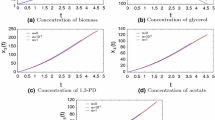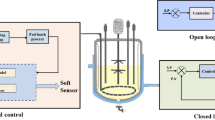Abstract
Previous studies have shown that the rate of formation of streptokinase, a secondary metabolite, in batch fermentation is proportional to the specific growth rate of the biomass, which in turn is inhibited by its substrate and the primary product (lactic acid). These kinetics suggest the suitability of fed-batch operation to increase the yield of streptokinase. A near-optimal feed policy has been calculated by the chemotaxis algorithm, and it shows a substrate feed rate decreasing nonlinearly and vanishing after 11 hours. This is followed by batch fermentation for a further 8 hours, at the end of which 12% more streptokinase is generated than by purely batch fermentation. Further improvements in productivity are possible.
Similar content being viewed by others
Abbreviations
- k dh−1 :
-
decay constant for active cells
- k ph−1 :
-
decay constant for streptokinase
- K Igl−1 :
-
inhibition constant for lactic acid
- KS gl−1 :
-
inhibition constant for substrate
- M gl−1 :
-
lactic acid concentration
- P gl−1 :
-
streptokinase concentration
- Q 1h−1 :
-
substrate feed rate
- S gl−1 :
-
substrate concentration
- S ingl−1 :
-
inlet concentration of substrate
- t h:
-
time
- t bh:
-
end-point of batch fermentation
- t fh:
-
end-point of fed-batch fermentation
- V l:
-
volume of broth in fermenter
- V 0 l:
-
initial value of V (at t=0)
- V ml:
-
maximum value of V
- X gl−1 :
-
total biomass concentration
- X agl−1 :
-
concentration of active biomass
- Y MX :
-
yield coefficient for lactic acid from biomass
- Y PX :
-
yield coefficient for streptokinase from biomass
- Y XS :
-
yield coefficient for biomass from substrate
- μ h−1 :
-
specific growth rate of biomass
- μ mh−1 :
-
maximum specific growth rate
References
Estrada, M.P.; Hernandez, L.; Perez, A.; Rodriguez, P.; Serrano, R.; Rubiera, R.; Pedraza, A.; Padrou, G.; Antuch, W.; de la Fuente, J.; Herrera, L.: High level expression of streptokinase in Escherichia coli. Bio/Technol. 10 (1992) 1138–1142
Hagenson, M.J.; Holden, K.A.; Parker, K.A.; Wood, P.J.; Cruze, J.A.; Fuke, M.; Hopkins, T.R.; Stroman, D.W.: Expression of streptokinase in Pichia pastoris yeast. Enzyme Microb. Technol. 11 (1989) 650–656
Huang, T.T.; Malke, H.; Ferretti, J.J.: The streptokinase gene of group A streptococci: cloning expression in Escherichia coli, and sequence analysis. Mol. Biol. 2 (1989) 197–205
Malke, H.; Ferretti, J.J.: Streptokinase: cloning, expression and excretion by Escherichia coli. Proc. Natl. Acad. Sci. USA. 81 (1984) 3557–3561
Lee, S.B.; Seressiotsis, A.; Bailey, J.E.: A kinetic model for product formation in unstable recombinant populations. Biotechnol. Bioeng. 27 (1985) 1699–1709
Stuebner, K.; Boschke, E.; Wolf, K.-H.; Langer, J.: Kinetic analysis and modelling of streptokinase fermentation. Acta Biotechnol. 11 (1991) 467–477
Modak, J.M.; Lim, H.C.; Tayeb, J.J.: General characteristics of optimal feed rate profiles for various fed-batch processes. Biotechnol. Bioeng. 28 (1986) 1396–1407
Yamane, T.; Shimizu, S.: Fed-batch techniques in microbial processes. Adv. Biochem. Eng./Biotechnol. 30 (1984) 147–194
Wolf, K.-H.; Venus, J.; Stiebitz, O.: Acta Biotechnol. 7 (1987) 55–59
Constatinides, A.: Application of rigorous optimization methods to the control and operation of fermentation processes. Ann. N.Y. Acad. Sci. 326 (1979) 193–221
Fishman, V.M.; Biryukov, V.V.: Kinetic model of secondary metabolite production and its use in computation of optimal conditions. Biotechnol. Bioeng. 4 (1974) 647–662
San, K.-Y.; Stephanopoulos, G.: Optimization of fed-batch penicillin fermentation: a case of singular optimal control with state constraints. Biotechnol. Bioeng. 34 (1989) 72–78
Takamatsu, T.; Hashimoto, I.; Shioya, S.; Mizuhara, K.; Koike, T.; Ohno, H.: Theory and practice of optimal control in continuous fermentation processes. Automatica 11 (1975) 141–148
Wei, D.; Parulekar, S.J.; Weigand, W.A.: Multivariable control of continuous and fed-batch bioreactors. Ann. N.Y. Acad. Sci. 589 (1990) 508–528
Gagnepain, J.P.; Seborg, D.E.: Analysis of process interactions with application to multiloop control system design. Ind. Eng. Chem. Proc. Des. Develop. 21 (1982) 5–11
Lim, H.C.; Tayeb, Y.J.; Modak, J.M.: Computation algorithms for optimal feed rates for a class of fed-batch fermentations: numerical results for penicillin and cell mass production. Biotechnol. Bioeng. 28 (1986) 1408–1420
Cuthrell, J.E.; Biegler, L.T.: Simultaneous optimization and solution methods for batch reactor control problems. Comput. Chem. Eng. 13 (1989) 49–62
Hong, J.: Optimal substrate feeding policy for a fed-batch fermentation with substrate and product inhibition kinetics. Biotechnol. Bioeng. 28 (1986) 1421–1431
Luus, R.: Optimization of fed-batch fermenters by iterative dynamic programming. Biotechnol. Bioeng. 41 (1993) 599–602
Montague, G.A.: Ward, A.C.: A suboptimal solution to the optimisation of bioreactors using the chemotaxis algorithm. Process Biochem. 29 (1994) 489–496
Bremmerman, H.J.; Anderson, R.W.: An alternative to back propagation: A simple rule for synaptic modification for neural network training and memory. Intenal Report, Department of Mathematics, Univ. California, Berkeley, CA (1989)
Patnaik, P.R.: Parametric sensitivity of streptokinase fermentation through model reduction by a semi-empirical approach. Hung, J. Ind. Chem. 23 (1994) in press
Asenjo, J.A.; Sun, W.-H.; Spencer, J.L.: Optimization of batch processes involving simultaneous enzymatic and microbial reactions. Biotechnol. Bioeng. 37 (1991) 1097–1094
Author information
Authors and Affiliations
Rights and permissions
About this article
Cite this article
Patnaik, P.R. A heuristic approach to fed-batch optimisation of streptokinase fermentation. Bioprocess Engineering 13, 109–112 (1995). https://doi.org/10.1007/BF00420437
Received:
Issue Date:
DOI: https://doi.org/10.1007/BF00420437




